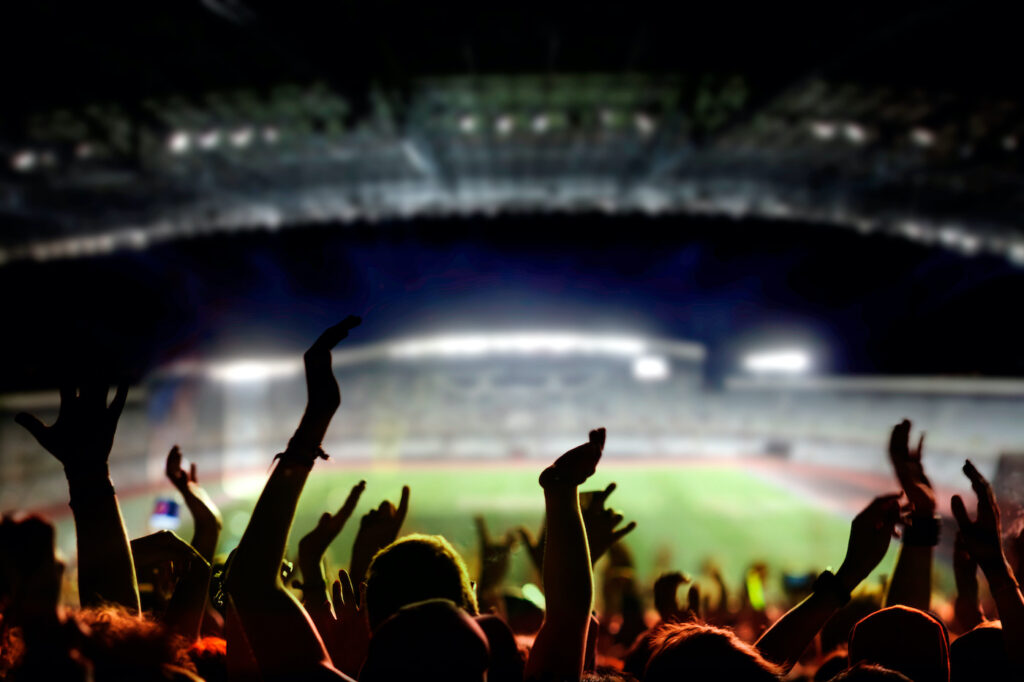Shadi Hamid is a man of The Establishment. His credentials include being a professor of Islamic studies, a senior fellowship at the august, center-left Brookings Institution, and a gig as a contributing writer at The Atlantic.
Joe Kent ran on taking down that establishment. The retired Green Beret and Gold Star husband won his primary for a semi-rural congressional district in Washington state by unapologetically going full MAGA, before losing in the general election by 2,656 votes, the biggest election night upset of 2022.
Hamid and Kent’s views have little in common, save one contrarian impulse—they both find America’s love affair with professional sports annoying, if not downright deleterious.
Last month, as the Philadelphia Eagles punched their ticket to this weekend’s Super Bowl, Hamid found himself in a curmudgeonly mood: “The idea of (publicly) wearing a jersey and orienting your whole day around getting excited about a game where people run into each other with helmets is vaguely annoying,” he posted in a since-deleted tweet.
Start your day with Public Discourse
Sign up and get our daily essays sent straight to your inbox.Likewise, Kent was sufficiently annoyed by the “bread and circuses” aspect of last year’s Super Bowl to vent his frustrations. How can people, he wondered, “watch pro sports [and] major corporations spreading woke propaganda while convincing men that the masculine thing to do is watch other men compete in a silly game”?
As the socialist web magazine Current Affairs pointed out, the left has a long history of finding sports problematic, “irrational, a distraction from the Very Serious Business of politics, a ‘bread and circuses’ corporate spectacle.” But the argument crosses the political divide. Conservative commentator Lyman Stone has argued that sports have displaced other forms of community life, bluntly stating that “professional sports are decadent spectacles that embarrass the nation.” In the digital pages of The Spectator, reactionary writer Pedro Gonzales compared watching sports to watching pornography.
De gustibus, as they say, non est disputandum. If paleocons or socialists find no pleasure in the thrill of a buzzer-beater or the tension of the bottom of the ninth, it neither picks my pocket nor breaks my leg. But the insufferable condescension—that getting invested in sportsball is “cringe,” and that rooting for laundry is the opium of the unwashed masses—deserves to be pricked. Yes, modern-day sport is corrupt, venal, exploitative, craven, greedy, and, at times, lethal. It is, after all, made up of humans, who are all those things and more.
But gathering to take in these gaudy spectacles also provides a sort of community and a kind of identity. Beyond admiring the balletic excellence of a wide receiver or the crispness of a perfectly executed give-and-go—even beyond enjoying the chips and guac at a Super Bowl party—sports provide, at the very least, a shared experience, and even an ersatz brotherhood.
It goes without saying that high-fiving a stranger after a touchdown isn’t building authentic community. The tens of thousands who fill a stadium on a Saturday or Sunday share nothing of substance other than an emotional connection. And given that their loyalty is to a commercial product—one that thinks nothing of packing up and moving to another city when a better offer is on the table—some may wonder if we even call modern sports fandom any kind of positive civic practice.
But that view relies on a stunted understanding of how identities are formed. Shared loves, even loves of commercial goods, can be the basis for or the glue that cements more meaningful friendships or connections. How many college buddies or suburban dads would have fallen out of touch with old friends if a hole-in-one or fourth-quarter comeback didn’t inspire them to shoot off a quick text? How many Pittsburghers feel their heart beat a little quicker when they pass someone wearing black and yellow in a new town? Groups of friends don’t have to go full Silver Linings Playbook to have sports provide a reason to gather, reminisce, hope, celebrate, or mourn together.
Shared loves, even loves of commercial goods, can be the basis for or the glue that cements more meaningful friendships or connections.
And in our denuded age, when deeper forms of identity and commitment are increasingly being eaten away, a little more ceremony and civic pride, even if bought for $90 at the team store, is to be welcomed. As anyone who’s experienced a game day in a college town can attest, walking around city streets draped in local colors helps build a certain regional solidarity. Think of the clan-like rituals that kick off professional football games—blowing a horn, raising a flag, lighting a (virtual) cauldron. Like singing a college’s Alma Mater, they press back against the coolly rational side of everyday life. Getting swept up in the wave is a small blow against the above-it-all jadedness of the individual consumer.
Some have the opposite concern. If cheering on the hometown nine is successful in bringing communities together, that itself may be a problem. Sports, they fear, have been too successful at creating simulacra of community and associational life, crowding out the real things. In a sprawling report for the American Enterprise Institute, Stone worries that a “rise in sports culture has coincided with a weakening in other forms of social capital and an expansion of the state.” Perhaps without Thursday, Sunday, and Monday Night Football taking up our evenings, we’d have more time for our local high school’s Friday Night Lights and other forms of local association.
There is no question that the rise of mass entertainment has turned leisure into a more solitary pursuit. In Bowling Alone, Robert Putnam chalked up one-quarter of the decline in social capital to television alone. But participation in associational life has ebbed with every successive generation, across varying races, education levels, and, presumably, levels of interest in sports. The Netflix queue is long, social media beckon, and video games get better each year. If a new, doubtless very different, Emperor Theodosius were to ban professional sports, one would not expect a flourishing of American associational life.
At their best, sports should be experienced communally, whether in person or group chats, instead of through the disintermediation of an anonymous fantasy league or gambling app. That does not mean that affection, just like any other, can avoid becoming disordered. As a believer, I think the tailgaters whose Sunday morning worship site is a parking lot and whose communion is a brat and red Solo cup are making a regrettable choice. The bloodthirstiness of fans who cheer injuries and the violence that stems from rivalries are two obvious ways that the social bonds formed by pro sports can turn poisonous.
And football, in particular, has a relationship with violence that implicates the viewer. It wasn’t that long ago that the concussion crisis seemed likely to upend the future of America’s most popular sport. A decade ago, the libertarian polymath Tyler Cowen sketched out a potential vision of what it might take for football to be dethroned—a wave of concussion-related lawsuits, rising insurance costs, all parents save those with no other options keeping their kids from playing such a violent game. And only a few weeks ago, a monumental clash between two top teams was canceled as paramedics rushed to midfield to save a player from the grasp of death.
The outpouring of love and support for Damar Hamlin was truly heartwarming. But his freak injury was a reminder that any game that involves 250-pound men launching themselves into one another carries an element of inherent danger, to the point of lethality. As we’ve learned more about chronic traumatic encephalopathy (CTE), the defense that players “knew what they were getting into” rings a bit hollow. Formula 1 racing, a sport gaining in popularity thanks to the popular Netflix series Drive to Survive, is another sport that involves an uncomfortable willingness to put lives on the line for that extra split-second of speed.
Intellectuals disagree on whether watching football makes one complicit in violence. Moral theologian Charlie Camosy has talked about boycotting the game, while Fr. James Martin, the Jesuit writer, is one of the many who are uncomfortable with the violence of the game while also endorsing the words to “Fly, Eagles, Fly.”
There is no easy way to reconcile these tensions. Men have always been daredevils for money, attention, or fun. And while the game has gotten safer, the force and speed that are integral to the NFL are part of what draws people in. Yet even if more civilized pursuits might be a more worthy way for America to come together, the 800-pound gorilla isn’t going anywhere. When Cowen and his coauthor wrote their 2012 piece forecasting a potential end to football, the NFL’s revenue was around $8 billion. Today, the NFL brings in about $18 billion annually.
When so few topics avoid being translated through the lens of partisan politics, having largely apolitical aspects of community life to be able to join in full-throatedly should be unabashedly encouraged.
In fact, it seems like the only real threat to sports over the long run may be its monetary success. Pro sports have launched themselves into a headlong embrace of gambling, which transforms the viewing experience into something more adversarial and mercenary. Teams chasing luxury box dollars at the expense of the bleachers, or blacking out their most loyal fans to push more expensive subscription packages, are eating their seed corn and making it less likely that future generations will have the same attachment. College sports, too, are selling their birthright, not in the form of much-needed licensing deals for amateur players, but in the pursuit of TV revenue above all other goods (any measurement of “success” that ends up with UCLA playing Rutgers on any given night instead of its in-state rivals is clearly miscalibrated). These moves should, obviously, be resisted.
For there’s also a final, more prosaic way sports contribute to stronger social capital: they give us something to talk about at the proverbial water cooler. The NFL, in particular, is the last remaining vestige of the monoculture. Movies, music, and TV shows have fragmented, with niche programming promising smaller and smaller slices of the population more of what they want. Meanwhile, according to Nielsen data compiled by the sports business site Sportico, 82 of the 100 most-watched TV broadcasts of 2022 were NFL games. Of the top 30 most-viewed live events in 2022, only two were not pro football: The State of the Union and coverage of the midterm election returns.
When so few topics avoid being translated through the lens of partisan politics, having largely apolitical aspects of community life to be able to join in full-throatedly should be unabashedly encouraged. (And why the heavy-handed woke messages from pro sports leagues during the summer of Coronavirus and George Floyd were so poisonous.) Embracing identities and debates that are orthogonal to our political divides is a key to making the American experiment work. As none other than Shadi Hamid wished in 2021: “If only Americans could begin believing in politics less fervently, realizing instead that life is elsewhere.”
That “elsewhere” rightly includes grandstands, box seats, and the living room couches of Super Bowl watches across the nation. Don the jersey, embrace the pageantry, and invite friends over for seven-layer dip. Celebrating the communal element of professional sports, ignoring the cynics, and intentionally pushing back against individualism, is the right way to celebrate this most American of weekends.














